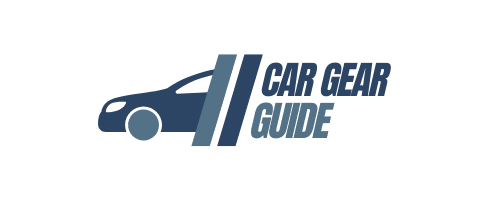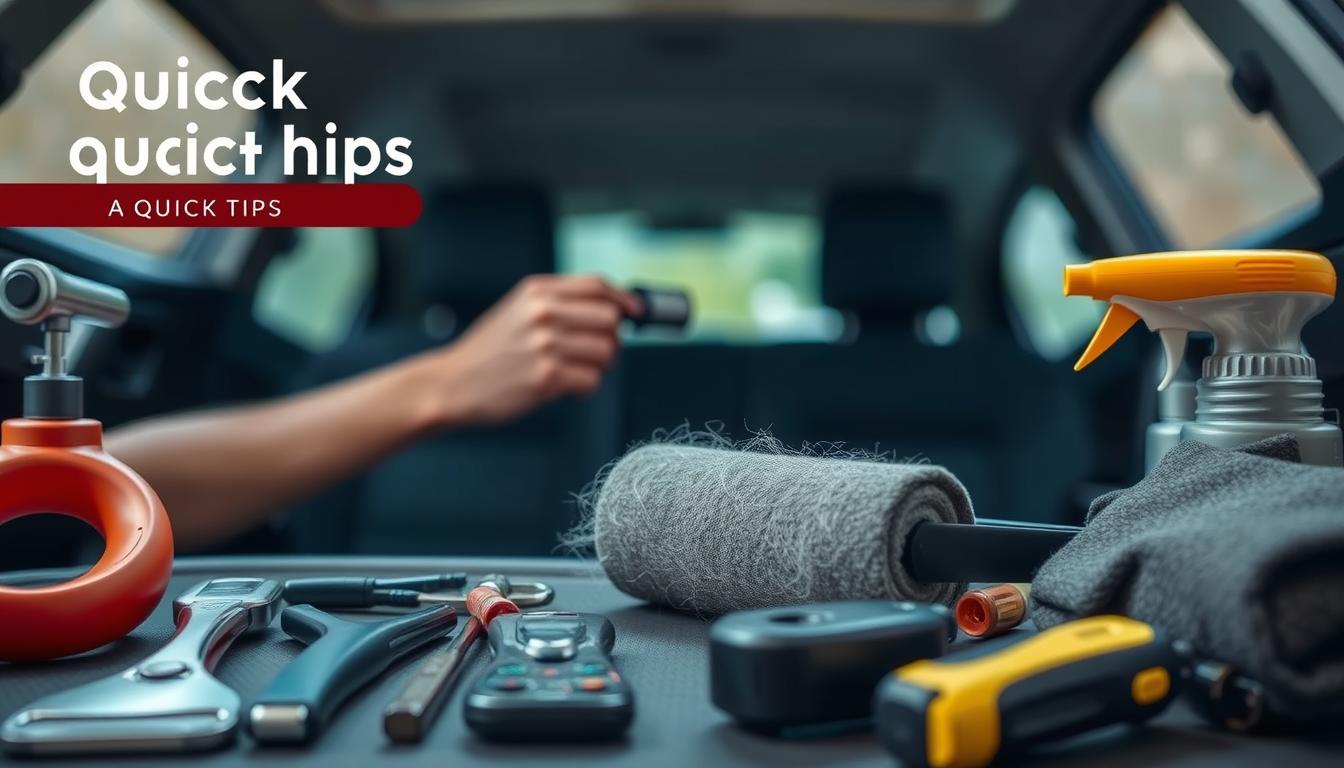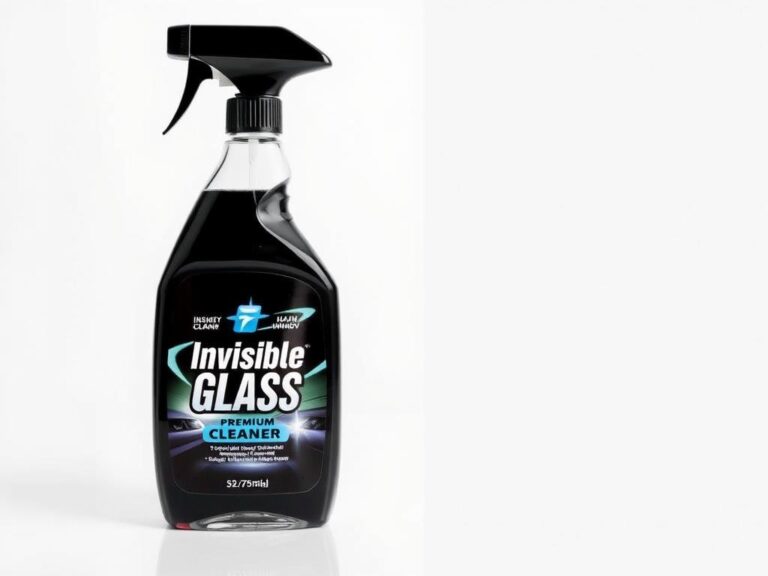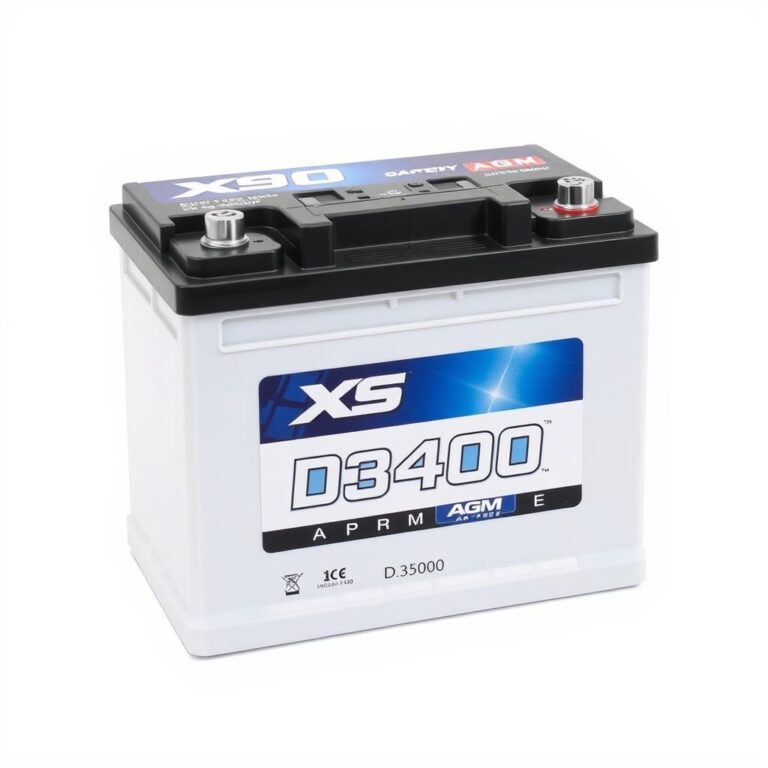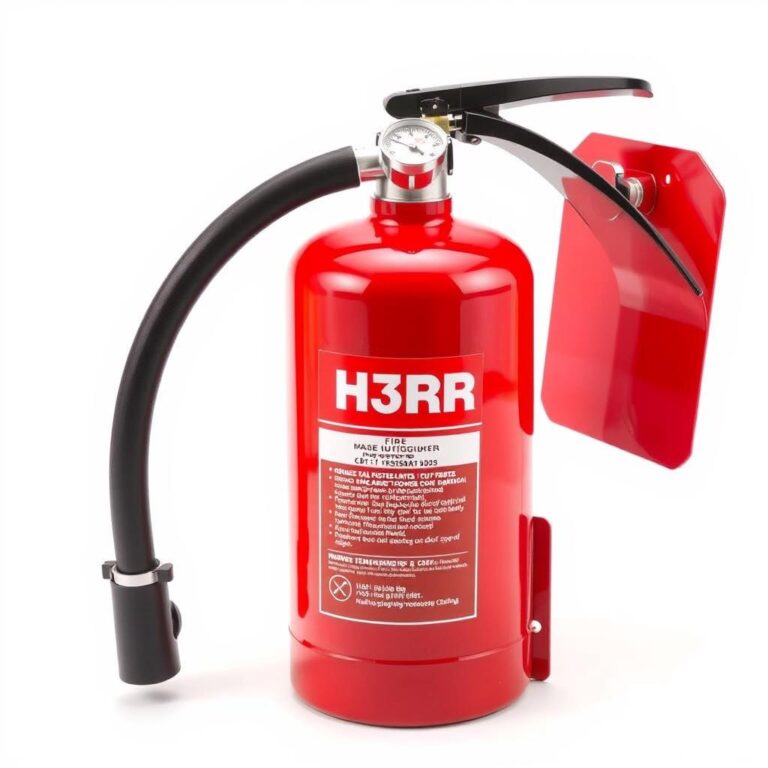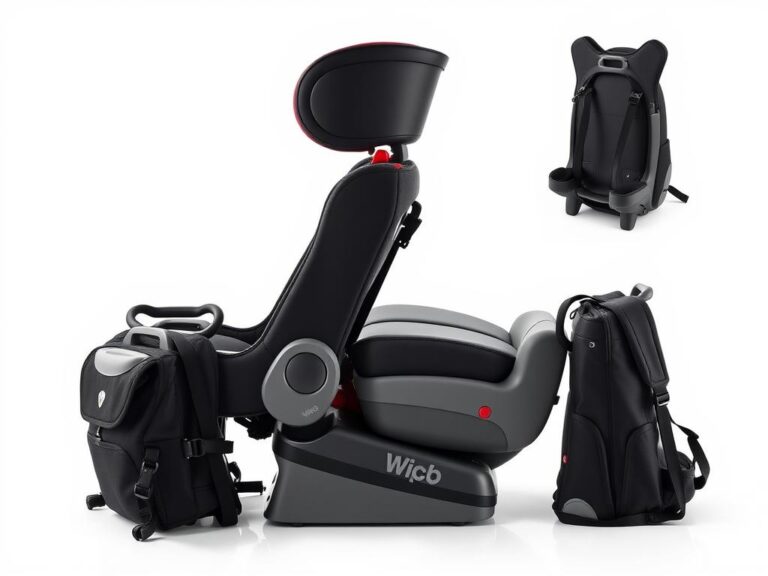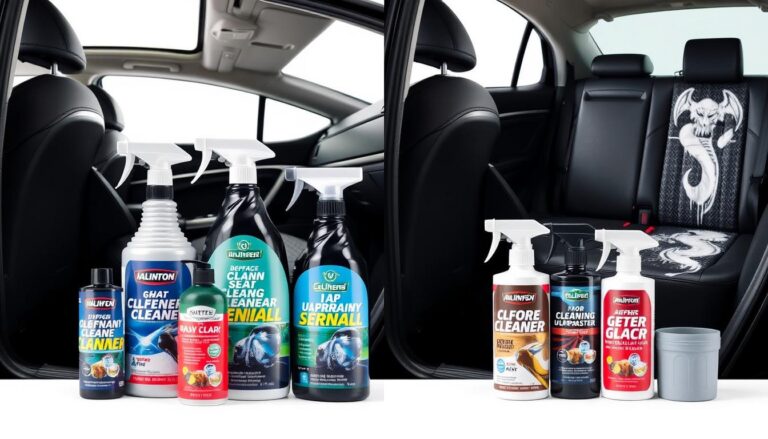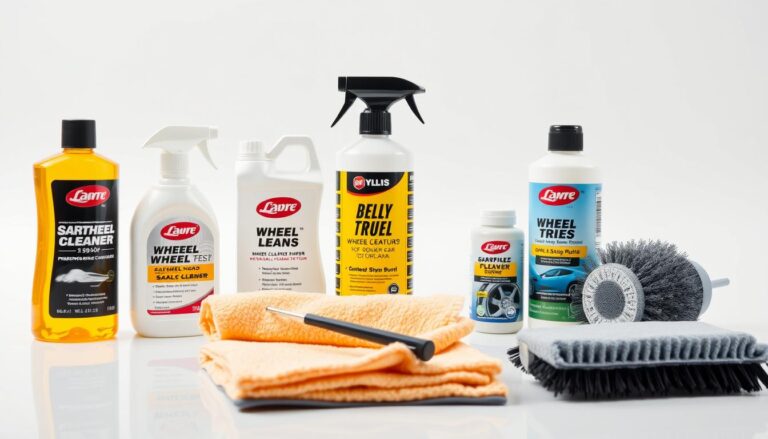Best Way to Get Dog Hair Out of Car – Quick Tips
Want a clean car fast and without much trouble? Use a layered method to remove dog hair. First, reduce static. Then use a rubber brush to loosen the hair. Finally, vacuum it up with a strong suction. This way, you remove most of the fur in one go.
This guide will help you get real results. It uses simple science to beat static and get fibers moving. It also shows you the best ways to use your tools. On thicker carpets, a rubber brush from Chemical Guys gets rid of hair quickly. For tighter spots, like short-pile seats, try a Bissell turbo tool or a MetroVac crevice tool.
Got a little bit of dog hair? You can clean it up in 10–20 minutes. First, spray lightly to tackle static. Then, use a rubber squeegee to collect the hair. Finish by vacuuming in the direction of the fabric. This way, you avoid doing the same spot over and over.
We tested different tools and methods. We checked out reviews from Amazon, Home Depot, and AutoZone. We also looked into tips from experts at 3M and Chemical Guys. Our goal was to find the best ways to clean fabric seats, carpets, and cargo areas without using harsh chemicals.
Here’s what most people need to know: To remove pet hair, use a rubber brush and a strong vacuum. Work in small, overlapping strokes. Remember to handle static. This method works well every time, even if your car got messy from a trip to the beach or a hike in the rain.
Need to clean up quickly? Try these tips. Use a glove to get hair out of tight spots. Velcro can help with tough spots on trunk liners. A HEPA filter vacuum can reduce pet dander and odors. Each tip is chosen to save you time, effort, and frustration.
By the end of this guide, you’ll know which tool to use where and why it works. From loosening the hair to picking it up and vacuuming, it’ll be straightforward. You’ll see the difference in your seats, carpets, and cargo space.
Why Dog Hair Sticks to Car Interiors
To know how to clean car interiors from dog hair, it’s useful to understand why it sticks. Knowing the reasons makes cleaning for pet hair easier and more effective.
Static Electricity and Fabric Types
When synthetic fibers and fur touch, static builds up. This makes materials like polyester, nylon, and polypropylene attract hair like magnets. In dry conditions, under 30% humidity, this issue gets even worse.
Compared to cotton blends, short-pile cloth and many carpets catch more hair. This explains why some vehicles are hairier than others. By understanding the materials, you can better plan your cleaning strategy.
Moisture, Oils, and Embedded Fur
Dog coat oils and dust create tiny bonds on fabric fibers. These bonds cause hair to stick deeper into materials, making it hard to remove with just a quick sweep.
When detailing a car for pet hair, it’s crucial to address this. A bit of moisture reduces static, and gentle scrubbing helps release the stuck hair. This makes cleaning more effective.
Common Problem Areas Inside Vehicles
The most hair gathers in areas of high use. Seat bolsters catch hair when pets jump in or out. Cargo liners and tight corners also trap a lot of fur.
Surprisingly, HVAC systems can blow hair onto headliners and into crevices. Even under child seats become hair magnets. Mapping these areas helps make your cleaning efforts quicker and more thorough.
Essential Dog Hair Removal Tools for Car Detailing
To quickly remove pet hair from car interiors, these tools are top choices. They use friction and agitation to lift hair. You can find the perfect tool for any seat fabric, pile height, or crevice depth based on price, durability, and user reviews.
Rubber Brushes and Squeegees
Rubber edges make removing hair easy with just a bit of pressure. The Lilly Brush Detailer has a polypropylene handle and a rubber blade for pulling hair from tight spots. The Fur-Zoff, crafted from recycled glass foam, is great for carpets where hair sticks because of static.
Chemical Guys’ Rubber Pet Hair Brush works great on medium-pile mats. Its squeegee blades line up fur for easy vacuuming, making hair removal more effective.
Lint Rollers, Sticky Sheets, and Velcro Blocks
Lint rollers and sticky sheets quickly pick up hair on the surface. They’re great as a final step after using rubber tools. Velcro blocks, with their loop-side, pull hair from fabrics through short tugs.
Before using Velcro, try it on a small, hidden spot. It might damage delicate fabrics, but it’s great for hair removal without chemicals.
Pumice Stones and When to Use Them Safely
Pumice tools can remove hair embedded in tough carpeted mats. Use gentle strokes and avoid them on leather, vinyl, Alcantara, or thin fabrics to prevent damage.
Use painter’s tape to protect plastic trim from scratches. Pumice stones can quickly clean car floors that trap a lot of hair.
Specialized Pet Hair Removal Attachments for Vacuums
Vacuum attachments enhance cleaning with agitation. Tools like the Dyson Pet Groom/mini motorized tool, Bissell Pet TurboBrush, and MetroVac Turbo nozzles are great for quick hair removal. They help get hair out from tight spots.
Choose attachments with narrow heads for crevices, silicone edges to avoid fabric damage, and adjustable airflow for efficient cleaning.
| Entity | Type | Key Attributes | Best Use Case | Notable Value |
|---|---|---|---|---|
| Lilly Brush Detailer | Rubber blade tool | Polypropylene handle; rubber edge; compact form | Cloth seats and tight weave upholstery | High control in seams and stitching lines |
| Fur-Zoff | Recycled glass foam block | Abrasive texture; rigid block; long wear | Stubborn carpet and floor mats | Strong friction lifts embedded hair fast |
| Chemical Guys Rubber Pet Hair Brush | TPR bristle brush | Flexible bristles; wide face; easy to clean | Medium-pile mats and cargo areas | Quick gather into rows for vacuuming |
| Scotch-Brite Lint Roller | Adhesive roller | Tear-off sheets; tacky adhesive; portable | Top-layer pickup and final touch | Best as a finishing pass to reduce residue |
| Loop-Side Velcro Block | Mechanical grab tool | Loop surface; rectangular grip; reusable | Cloth seats with deep nap | Strong pull on embedded strands—test fabric first |
| Pumice Scouring Stick | Pumice stone | Porous abrasive; rigid block; edges for lines | Thick carpeted mats only | Avoid leather, vinyl, and delicate cloth |
| Dyson Mini Motorized Tool | Vacuum attachment | Powered brush; narrow head; strong agitation | Seat seams and stair-step carpet | Pairs well with low airflow to prevent lift |
| Bissell Pet TurboBrush | Vacuum attachment | Turbine-driven brush; compact; easy swap | Upholstery and cargo panels | Good balance of agitation and suction |
| MetroVac Turbo Nozzle | Vacuum attachment | Silicone lip; narrow profile; robust build | Crevices and tight corners | Minimizes snagging on delicate fabrics |
Vacuuming Techniques That Actually Work
Want better results with less work when removing pet hair? Think about suction strength and how it shakes up fibers. Corded vacuums with powerful airflow are great for pulling hair to one spot. This is crucial for car detailing for pet hair. A good setup means you won’t have to go over the same spot many times. This saves time and covers essential tips for cleaning dog hair in car.
Setting Up: Crevice Tools and Brush Heads
Begin with a crevice tool that’s 11–14 inches long. Use it along the seams of seats, the edges of rails, and door-sill carpets. Next, use a brush made for pet hair or a turbo tool for seats and the floor of the car. To keep suction strong, use a shop vac with 5–6.5 peak HP. Or, use a specific model like the MetroVac Vac N’ Blo. Both are great for keeping air moving for car detailing for pet hair.
Cordless options like the Dyson V15 or Tineco are good for car seats. They have mini heads powered by motors. You might need to switch batteries for large jobs. This plan is easy and matches well with tips for cleaning dog hair in car, without taking extra time.
Short Strokes vs. Long Passes
Use small, tight strokes of 2–4 inches to lift fibers instead of pressing them down. This method stirs up the upholstery and prevents hair from sticking, making your cleaning more effective. Long strokes can miss hair and spread dirt around.
Always work from the front of the car to the back. This way, any loose hair moves to the back for easy removal. This helps you clean efficiently, supporting great car detailing for pet hair and keeping the car neat.
Brushing and Vacuuming in Alternating Passes
Stand fibers up with a rubber brush, then vacuum right away. Do this for each section until it looks even and clean. This back-and-forth method stops hair from settling back down and catches more hair quickly.
This approach is a top strategy for tips for cleaning dog hair in car. It works especially well with vacuums that have strong suction, grabbing tight hairs well.
HEPA Filters and Odor Control
Use HEPA H13 filters to catch dander and tiny dust. Add a carbon prefilter to cut down on odors during car detailing for pet hair. After you’re done, use a specific deodorizer like Meguiar’s Whole Car Air Re-Fresher. It gets rid of smells without using strong scents.
With clear filters and constant airflow, your cleaning will be steady. This helps you follow core tips for cleaning dog hair in car every time you detail.
Prepping the Car: Quick Steps Before You Start
For faster results and less effort, start by setting up your car. This preparation stops static and loosens trapped fur. It makes cleaning dog hair from your car’s interior more efficient.
Tip: Open all doors for better airflow. This helps fabrics dry faster after spraying.
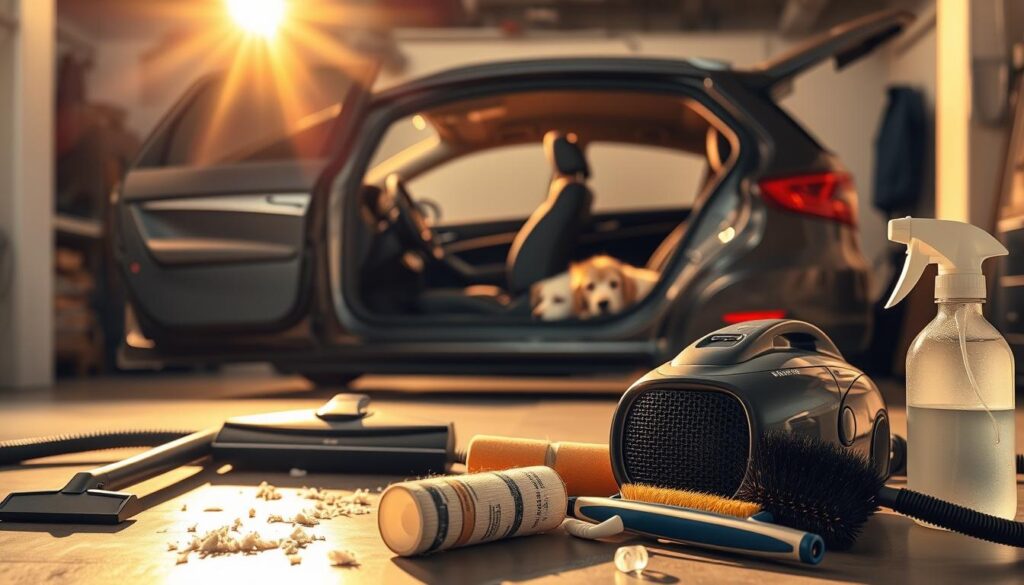
Remove Floor Mats and Loose Items
Begin by removing floor mats, cargo mats, blankets, and storage bins. This prevents hair from getting trapped under these items. Also, empty the cupholders and door pockets.
This makes it easier for your tools to reach every area. It prepares your car for a thorough cleaning.
Shake, Beat, and Pre-Vacuum Mats
Take your mats outside and give them a good shake. Hit their back against a curb edge or use a rubber mallet. This helps loosen the fur.
Then, use a vacuum with a wide nozzle for a first pass. This step gets rid of the most hair, making detailed cleaning quicker.
Light Mist Sprays to Reduce Static
Spray seats and carpets lightly with distilled water or a mix of isopropyl alcohol with water. But don’t make them too wet—just enough to reduce static. Always keep the doors open to let air in.
To make cleaning easier, lightly apply a detailer on vinyl and dashboards. It helps hair to not stick, making it easier to clean.
best way to get dog hair out of car
To make cleaning up faster and easier, try a three-step method. This effective process combines shaking up the hairs, powerful suction, and a final sweep for a clean finish. It’s a great way to clean dog hair from your car seats, backrests, and floor mats efficiently.
Layered Approach: Loosen, Gather, Extract
Loosen: Start by lightly misting the car’s upholstery. Use a rubber brush to lightly brush the fabric. This helps dog hair come to the top. Use quick, short strokes to avoid pushing the dirt deeper.
Gather: Next, use a rubber squeegee or the Lilly Brush Mini Pet Hair Detailer. Group the hair into neat rows. You move from the middle of the seats to the edges. This prepares hair for the next cleaning step.
Extract: Now, vacuum up the rows of hair with a strong, narrow nozzle. After that, use a pet turbo head to catch any remaining hairs. This method keeps dog hair from spreading around again when you’re cleaning carpets.
Rubber Tool + Vacuum Combo Method
Combine short strokes with immediate vacuuming. This technique stops hairs from getting stuck again. It’s especially good for cleaning car areas that are hard to reach, like tight corners and seams.
- Entity: Lilly Brush Mini Pet Hair Detailer → Attribute: edge profile → Value: crisp, 90° lip for pile control
- Entity: Dyson V12 Detect or Shark Stratos → Attribute: turbo tool → Value: motorized brush for fine hair pickup
- Entity: Narrow crevice nozzle → Attribute: orifice size → Value: concentrated airflow for maximum lift
Finishing Pass with Microfiber and Detailing Spray
Use a damp, high-pile microfiber cloth and a balanced cleaner (pH ~7) for your last step. Brands like Chemical Guys or Meguiar’s are good choices. This last step smooths out the fabric appearance, removes fine particles, and helps prevent static. Your car’s interior not only looks good but feels clean too.
This cleaning method works well on different parts of your car like the cloth seats, floor mats, and trunk liners. Be gentle when cleaning the ceilings to avoid damage.
| Tool/Product | Primary Role | Key Attribute | Practical Value | Where It Excels |
|---|---|---|---|---|
| Lilly Brush Mini Pet Hair Detailer | Gather | Firm rubber edge | Forms linear piles fast | Seat centers to edges |
| Rubber Squeegee (short handle) | Gather | Wide blade | Covers large areas quickly | Floor mats and cargo liners |
| Dyson V12 Detect/Shark Stratos (pet tool) | Extract | Motorized turbo head | Lifts embedded hair | Backrests and bolsters |
| Narrow Crevice Nozzle | Extract | Concentrated airflow | High suction on piles | Seams and seat rails |
| Microfiber + pH‑neutral detailer | Finish | pH ~7, damp wipe | Reduces static, evens nap | Final pass on all fabrics |
Dog Hair Cleaning Hacks for Faster Results
Looking for quicker cleanups without a big clean? These hacks cut down on static and pull up hair fast. They offer easy ways to get dog hair out of car seats and carpets. No fancy tools needed.
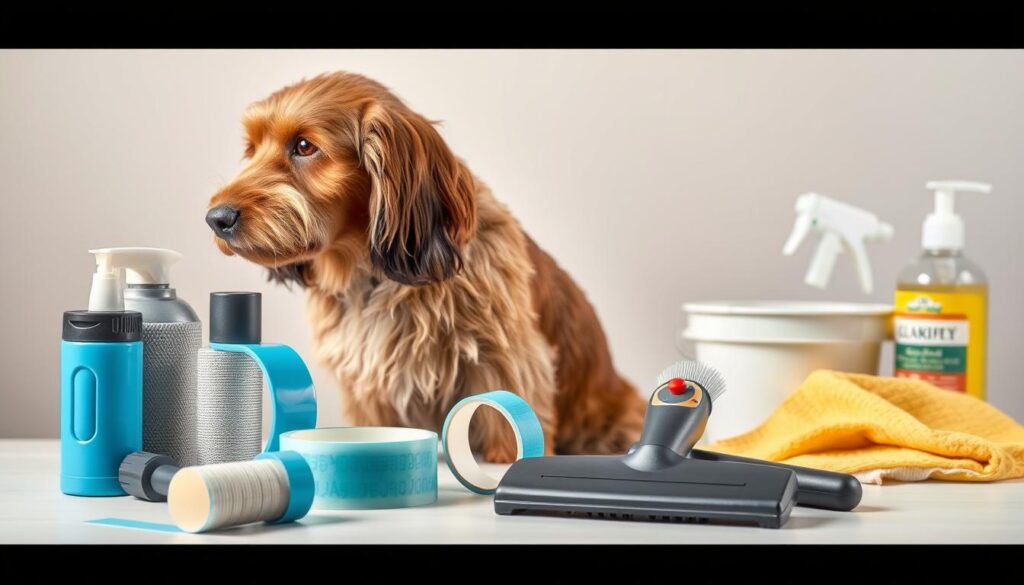
DIY Static-Reducing Fabric Softener Spray
Combine 1 part liquid fabric softener with 10 parts water in a spray bottle. Mist your car’s seats and carpets lightly, wait a few minutes, then brush and vacuum away the hair. The softener helps fibers let go of hair, making it easier to clean.
Keep this trick for quick spots or regular car clean-ups. It’s great for keeping your car hair-free, even when you’re short on time.
Balloon and Dryer Sheet Tricks
Rub a blown-up latex balloon over the fabric to create a static charge that grabs loose hair. Collect the hair with a vacuum or a barely wet microfiber cloth.
Touch up with unscented dryer sheets to reduce static in areas you often touch. Move softly over the seats and doors. These tricks are perfect for light or moderate amounts of hair.
Latex or Nitrile Gloves for Quick Sweeps
Wet latex or nitrile gloves slightly and swipe in one direction to gather hair into balls. It works well on seatbacks and other areas. A vacuum can clear away the piles afterward.
These are easy tips for cleaning dog hair quickly, ideal after outdoor adventures or vet trips. Simple to store and fast to use.
| Hack | Best Use Area | Key Attribute | Practical Value | Notes |
|---|---|---|---|---|
| Fabric Softener Spray (1:10) | Cloth seats, carpets | Static reduction | Loosens embedded fur in 2–3 min | Brush, then vacuum; avoid over-wetting |
| Latex Balloon | Seat cushions, backrests | Localized charge | Lifts loose hair for easy pickup | Best for quick touch-ups |
| Unscented Dryer Sheet | Bolsters, door cards | Anti-static wipe | Reduces cling on light debris | Use gentle pressure on delicate fabric |
| Damp Latex/Nitrile Gloves | Seatbacks, cargo sides | Tacky sweep | Rolls fur into clumps fast | Vacuum clumps immediately |
Deep-Clean Routine for Stubborn Pet Hair
If your car needs a fresh start because of heavy shedding, try this deep-clean routine. It uses gentle shaking, heat, and safe cleaning solutions to get pet hair out of car seats and carpets.
Agitation with Drill Brushes and Upholstery Pads
For tough spots on carpets and cloth seats, use a drill brush attachment. Choose one with soft to medium bristles. Keep the drill on low speed, about 800–1,200 RPM, to protect the fabric. Clean a small area at a time and vacuum right after.
A dual-action polisher with a carpet brush pad is good for bigger areas. Pass it over gently, then use a crevice tool for the edges and under the seats. This helps lift the hair without damaging the fabric.
Steam Cleaning: Pros, Cons, and Safety
Steam cleaners use heat to make it easier to remove pet hair. Machines like the McCulloch MC1385 are strong but still gentle. Always move the nozzle to avoid soaking spots and use a microfiber towel to catch debris.
Be careful with steam. Too much can cause stains or damage. Use it with caution on sensitive parts of your car. It keeps your car’s interior safe while getting rid of pet hair.
Spot-Treating Cloth vs. Leather/Leatherette
For cloth seats, start with a cleaner like Bissell Professional. Spray lightly, then scrub softly. Use a wet/dry vacuum to remove the mixture. This makes it easier to get rid of pet hair with less effort.
For leather or leatherette, be gentle. Clean with products like Lexol or Leather Honey using a soft brush. As pet hair usually sits on top of these surfaces, a soft vacuum brush can remove it easily. This way, you protect the material while cleaning.
| Tool/Cleaner | Best Surface | Key Attribute | Recommended Use | Caution |
|---|---|---|---|---|
| Drill Brush (soft–medium nylon) | Carpet, cloth seats | Controlled agitation | 800–1,200 RPM; small sections; immediate vacuum | High speed can fuzz fibers |
| DA Polisher + Carpet Brush Pad | Large carpeted areas | Even pressure over wide zones | Slow passes; follow with crevice vacuum | Overworking seams can lift threads |
| Steam Cleaner (e.g., McCulloch MC1385) | Cloth, plastics, rubber | ~58 PSI heat loosens oils | Short bursts; nozzle in motion; towel catch | Avoid headliners; limit moisture |
| Bissell Professional Upholstery Cleaner | Cloth, carpet | pH 7–8, label dilution | Pre-spray, agitate lightly, extract | Do not oversaturate foam |
| Lexol / Leather Honey + Horsehair Brush | Leather, leatherette | Finish-safe cleaning | Gentle brush; wipe; vacuum soft brush | No harsh scrubbing or steam on seams |
Tip: Alternate between shaking and vacuuming. This method removes pet hair faster and keeps it from getting pressed back into the fabric.
Protective Measures to Prevent Future Buildup
To avoid frequent cleanups, use barriers and special treatments on fabrics. This makes the removal of pet hair easier and quicker, requiring less effort.
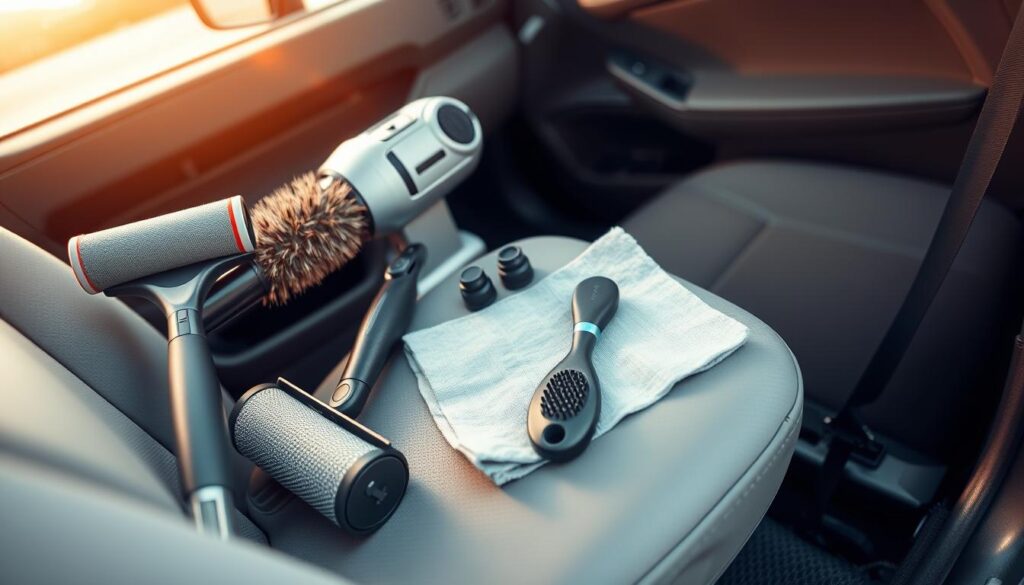
Seat Covers, Cargo Liners, and Barrier Nets
Physical barriers keep hair from getting into fabrics. 4Knines seat covers are made with strong polyester and have a no-slip backing. They don’t move even when you stop quickly. WeatherTech cargo liners catch dirt easily and are simple to clean with water.
For bigger vehicles, nets or hammock-style covers keep hair from moving to the front. This makes cleaning up easier and stops hair from getting caught in parts of the car.
| Product | Material | Key Attribute | Value | Care | Best For | CTA |
|---|---|---|---|---|---|---|
| 4Knines Seat Cover | Heavy-duty polyester | Backing | Non-slip, seat anchor | Machine-washable (gentle) | Bench seats, daily rides | Check Price on Amazon |
| WeatherTech Cargo Liner | Thermoplastic elastomer | Fitment | Custom-fit, raised lip | Hose off, air dry | Hatch and cargo areas | Check Price on Amazon |
| Hammock Barrier | Quilted fabric + straps | Coverage | Backseat to headrests | Vacuum, wipe clean | Blocking front-row transfer | Check Price on Amazon |
Regular Brushing of Your Dog Before Rides
Grooming your dog before driving can greatly reduce shedding. Use a FURminator to lift undercoat hairs and a rubber brush for the topcoat. This can lead to 30–50% less hair inside your car.
A compact lint brush can catch loose fur quickly. Keep one in the car for days when your dog sheds more.
Anti-Static Sprays and Fabric Protectants
Static makes hair stick to car fabrics. An anti-static spray helps you vacuum more easily. Using a fabric protectant on seats and carpets stops hair, spills, and stains from sticking.
Reapply protectants after big cleans, as advised on their labels. This makes future cleaning easier and protects fabrics.
Professional Dog Hair Removal for Cars
If you want your car’s seats to be cleaner, the air clearer, and to have less allergens, pro shops can help. They provide car detailing specifically for removing pet hair with specialized tools. These tools can get deep into the fabric fibres. When your own cleaning efforts aren’t enough, pro services are great, especially for thick carpets and cargo areas.
When to Call a Pro Detailer
Consider a pro when fur gets deeply embedded into your car’s carpet or after long trips. Or when allergies make top-notch cleaning a must. If vacuuming doesn’t remove all dander, a detailed cleaning can. This service is also perfect if you need to get rid of smells without using strong perfumes.
What a Pet-Hair Package Includes
Detailers use air and special rubber tools to pull out hair. Then, they use hot water and special vacuums to clean even more deeply. They might also steam clean tough fabrics and use special products to handle smells and stains.
- Air + Agitation: Compressed air and rubber tools work together to get the hair out.
- Extraction: A hot-water rinse and special vacuum catch hair and dirt.
- Deodorizing: Special products tackle the sources of bad smells.
This process makes sure your car gets thoroughly cleaned from pet hair, setting a standard for results.
Expected Costs and Turnaround Time
In the US, adding a pet-hair service to your car’s detailing could cost $75–$150. If you need a lot of hair removed, it could be $150–$300, based on how bad it is and your car’s size. Expect it to take 2–5 hours for a normal job, but a whole day for bigger problems.
| Service Level | Typical Inclusions | Price (USD) | Time | Key Questions to Ask |
|---|---|---|---|---|
| Add‑On Pet Hair | Compressed air, rubber agitation, HEPA vacuum | $75–$150 | 2–3 hours | HEPA rating, fragrance‑free choices |
| Heavy Removal | Air, agitation, hot‑water extraction, enzymes; optional steam | $150–$300 | 3–8 hours | pH of chemicals, ozone availability, hair removal guarantee |
For families concerned about allergies, check the filters and chemicals used ahead of time. This makes sure the service meets your needs without any surprises.
How to Clean Car With Dog Hair on Different Surfaces
To get clean seats, a clear cargo space, and a tidy roof liner, you need the right steps. This guide will help you clean your car of dog hair by surface. It will show you how to remove dog hair from car fabrics safely.
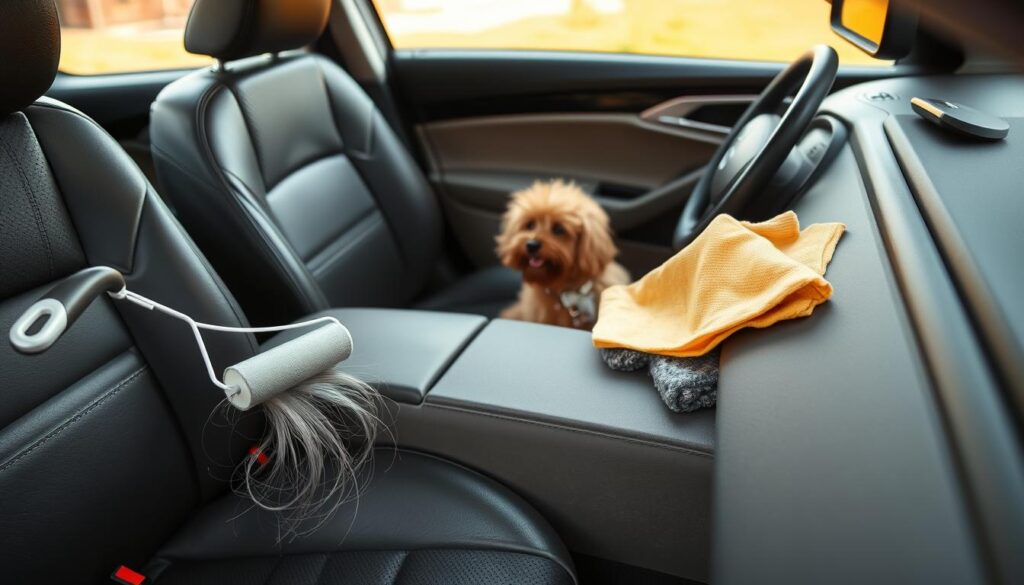
Cloth Seats and Carpeted Areas
Start by lightly spraying upholstery with distilled water to reduce static. Use a rubber pet-hair brush, such as the Lilly Brush or Fur-Zoff. Rake the fibers towards one pile using short, overlapping strokes.
Then, vacuum with a brush head using controlled, short movements. End by using a Scotch-Brite lint roller for strays along seams and on seat bolsters. Only use a pumice stone on thick floor mats, not on seats or thin carpet.
Trunk and Cargo Spaces
Clean large areas quickly with a rubber squeegee, like the Ettore 12-inch, pulling it in straight lines to collect hair. Then, use a shop vac with a wide-mouth nozzle to remove the piles in fewer goes.
For small spaces—like wheel wells and latch areas—use a pet turbo brush, such as the BISSELL Pet Turbo Eraser. Also, think about getting a removable cargo liner from WeatherTech or Husky for easier cleaning later.
Headliners and Delicate Panels
Headliners are delicate. Keep moisture minimal and suction light to prevent sagging. Use a soft brush attachment at a distance, then pick up hair with a clean microfiber cloth or a slightly damp nitrile-gloved hand.
For Alcantara and suede-like materials, use a gentle Alcantara-branded brush or horsehair and a light vacuum pass. Avoid pumice stones and sticky sheets that can damage the fibers. These methods safely remove dog hair from car headliners and trim while teaching you how to clean your car of dog hair without harming adhesives.
| Surface | Primary Tool | Technique | Risk to Avoid | Time (per seat/area) | Finish Step |
|---|---|---|---|---|---|
| Cloth Seats | Rubber pet-hair brush + vacuum | Pre-mist, short rakes, short vacuum passes | Pumice on fabric; over-wetting | 8–12 min | Lint roller on seams |
| Carpeted Floor | Pumice (thick mats) + brush | Rake to piles, vacuum in lanes | Pumice on thin carpet; long aggressive strokes | 10–15 min | Final vacuum with brush head |
| Cargo Space | Wide rubber squeegee + shop vac | Straight lanes, wide-mouth pickup | Skipping edges and tie-downs | 12–18 min | Pet turbo around wheel wells |
| Headliner | Soft brush attachment + microfiber | Low suction, lift hair at a distance | Heavy moisture; aggressive agitation | 5–8 min | Gloved hand for final lift |
| Alcantara/Delicate Panels | Alcantara/horsehair brush + light vacuum | Feather-light, one-direction passes | Sticky sheets; pumice | 6–9 min | Gentle groom to restore nap |
Quick Maintenance Routine: Weekly and Post-Trip Tips
Keep your cabin clean with less effort by following a simple plan. Start with quick post-ride touchups, add a weekly reset, and do a deep clean every season. This method helps keep fur from embedding, making cleaning easier and quicker. You’ll also find effective ways to remove dog hair from your car, saving both tools and time.
Five-Minute Post-Ride Clean-Up
After you park, shake out any blankets or covers you used. Then, with damp nitrile gloves, gather the hair on seats. Finish off by vacuuming the seat edges and floor mats’ front area.
These quick steps prevent fur from embedding in your car’s fabrics. By keeping a vacuum and gloves in your trunk, you can easily clean up loose hair.
Weekly Vacuum and Brush Plan
Set aside 10–15 minutes every week for this routine. Start by lightly misting areas that get a lot of touches to decrease static. Then, use a rubber brush on the seats and floor to gather hair. Vacuum the hair using a crevice tool to get into tight spaces.
Change up your tools—use rubber brushes for bulk removal and lint rollers for final touches. This method is both quick and thorough, perfect for keeping your car free of dog hair.
Seasonal Deep Clean Checklist
- Remove mats, beat them outside, and vacuum both sides.
- If necessary, loosen dirt in carpets with a drill brush and then vacuum thoroughly.
- Steam clean any heavily soiled areas and let them dry completely.
- Use fabric protectant on cloth areas and treat leather with cleaner and conditioner.
- Wash all covers and liners and put them back when dry.
- Change the cabin air filter if there’s still a smell after cleaning.
Doing a detailed clean every few months makes a big difference. It helps keep your cleaning routines quick and prevents fur from sticking to your car’s interior.
Conclusion
For quicker cleanups and less mess, there’s a smart way to remove dog hair from car interiors. It includes managing static, brushing up fibers, and thorough vacuuming. First, spray a gentle anti-static solution to decrease cling. Then, use a rubber brush or squeegee to gather the hair. Finish by vacuuming thoroughly, paying extra attention to seams with a crevice tool and using a brush head on fabric.
Choose your tools wisely. Only use a pumice stone for stubborn mats on durable carpet, and always try it in an unseen area first. To prevent hair from accumulating, invest in good seat covers and cargo liners from brands like WeatherTech or 4Knines. A simple weekly routine of brushing and then vacuuming can stop hair from getting stuck and keep your car smelling great.
If you’re dealing with a lot of hair or are worried about allergies, consider getting professional help. Car detailers offer special packages for dog hair that include high-grade vacuuming and steam cleaning safe fabrics. This service can quickly improve air quality and reduce smells. It’s a great complement to your regular cleaning routine and can help keep your car’s interior looking good.
The best approach for removing dog hair from cars is straightforward. Cut down on static, use rubber tools to collect hair, vacuum powerfully, and protect your car’s interior. Follow this plan and you’ll find each trip in your car becomes progressively cleaner.
